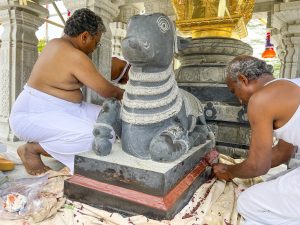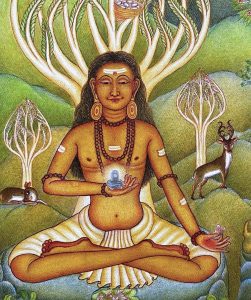“We are responsible for what we are, and whatever we wish
ourselves to be, we have the power to make ourselves.”
Swami Vivekananda (1863-1902)
An evil man is a saint of the future. See good in everything. Destroy the evil-finding quality. Develop the good-finding quality. Rise above good and evil. Swami Sivananda (1887-1963)
If the inner mind is not deluded, the outer actions will not be wrong. Tibetan proverb
You are awareness. Awareness is another name for you. Since you are awareness, there is no need to attain or cultivate it. Sri Ramana Maharshi (1879-1950)
Out of purity and silence come words of power. Swami Chinmayananda (1916-1992), founder of Chinmaya Mission
The winner has many friends; the loser has good friends. Mongolian proverb
Even the impossible becomes possible through devotion. Sarada Devi (1853-1920)
He who has created the universe is Himself present in all circumstances and conditions. Anandamayi Ma (1896-1982), mystic Bengali yogini saint
When the sea is calm, every ship has a good captain. Swedish proverb
A man sees in the world what he carries in his heart. Johann Wolfgang von Goethe (1749-1832), German poet
Sorrow prepares you for joy. It violently sweeps everything out of your house so that new joy can find space to enter. It shakes the yellow leaves from the bough of your heart so that fresh, green leaves can grow in their place. It pulls up the rotten roots so that new roots hidden beneath have room to grow. Whatever sorrow shakes from your heart, far better things will take their place. Rumi (1207-1273), Sufi mystic and poet
To understand the limitation of things, desire them. Lao Tzu (4th century bce), author of the Tao Te Ching
Nothing can dim the light which shines from within. Maya Angelou (1928-2014), American poet
Beyond the senses is the mind; above the mind is its essence (intelligence); beyond the intelligence is the great self; beyond the great (self) is the unmanifest. Katha Upanishad 2.3.7
Wealth is really a means to work out dharma. If one uses it merely for personal enjoyment, it is vainly spent. Sai Baba of Shirdi (1838-1918) Indian spiritual master
My brain is only a receiver; in the Universe there is a core from which we obtain knowledge, strength and inspiration. I have not penetrated into the secrets of this core, but I know that it exists. Nikola Tesla (1856-1943), Serbian-American inventor
Yoga is an internal practice. The rest is just a circus. K. Pattabhi Jois (1915-209), Hatha Yoga master
The essential nature of the self is to become one with the object deeply contemplated by it. If the sadhaka meditates continuously on a particular form, he assumes that form in due course. The nature of being one, the nature of being many and all such states are reflected in him according to his conception. All the qualities of the form meditated by him get unfolded within himself. Raurava Agama, Vidya Pada 7.13-4
Knowing your own darkness is the best method for dealing with the darknesses of other people. Carl Jung (1875-1961), Swiss psychiatrist
It is folly for a man to pray to the Gods for that which he has the power to obtain by himself. Epicurus (287- 212 bce) ancient Greek philosopher
We are all visitors to this time, this place. We are just passing through. Our purpose here is to observe, to learn, to grow, to love… and then we return home. Australian Aboriginal proverb
There is no baser folly than the infatuation that looks upon the ephemeral as if it were everlasting. Tirukural 331
When you’re meditating and you’ve managed to achieve a state of awareness being aware of itself, take notes on what it is that pulls you out of that state. See if it’s the same thing consistently, and then work to resolve it. Satguru Bodhinatha Veylanswami, publisher of Hinduism Today
Willpower is the soul in action. Satguru Sivaya Subramuniyaswami (1927-2001), founder of Hinduism Today
Did you know?
The Magic Mix for Cementing Murtis
One of the final touches of the May, 2023, crystal Sivalingam installation at Iraivan Temple in Hawaii was the application of a thin band of ashtabandhanam compound around the Sivalingam and its avudaiyar base, as well as the Nandi, kodimaram, balipitham and eight directional pithams. The ingredients of ashtabandhanam—literally, “eight bonds”—vary among India’s regions and even according to the Deity being installed. Iraivan temple’s famed architect, Ganapati Sthapati, listed the following eight: red soil powder, select river soils, frankincense, a type of cotton, shellac, mercury sulfide, beeswax, and dried butter made from buffalo milk. At the Hawaii temple, six more ingredients were added while heating the mixture: kumkum, sandalwood, camphor, turmeric, ghee and incense.

A traditional method of preparing the compound, still followed in parts of Kerala and elsewhere, is to pound the ingredients into a paste with 50-pound tamarind wood hammers (see youtu.be/U0dW0KPeGQM?t=599). At Iraivan, the mixture was purchased premixed and just heated over a flame to soften it.
K.P. Sarma of Vaikom, Kerala, explains in a 2022 Times of India article that for making just the three pounds required for a small murti, they have to strike the mixture at least 100,000 times to obtain the correct consistency. “The moment we stop hitting,” he said, “it starts to harden. Its texture resembles something like melting tar. Once the last ingredient, cotton, is added, it starts to solidify. Then, it must be applied on the murti immediately and left to dry for 41 days.” Then it becomes as hard as concrete.
The cementing takes place just before the final “awakening” of the Deity. In the case of Nandi murtis, this usually occurs shortly before the final carving to “open” His eyes.
The ingredients of ashtabandhanam have antiseptic qualities and serve the practical function of sealing the base of a murti, keeping out milk, yogurt and other offerings that might seep in and spoil.
Basics
What Are the Hindu’s Daily Yoga Practices?
Devout hindus perform daily vigil, called sandhya upasana, usually before dawn. This sacred period of puja, japa, chanting, singing, hatha yoga, meditation and scriptural study is the foundation of personal life.

Each day hundreds of millions of Hindus awaken for the last fifth of the night, bathe, don fresh clothing, apply sectarian marks, called tilaka, and sit in a clean, quiet place for religious disciplines. Facing east or north, the devotional puja rites of bhakti yoga are performed. Hatha yoga, hymn singing, japa and chanting are often included. Then follows scriptural study and meditation, listening to the sound current and contemplating the moonlike inner light during brahma muhurta, the auspicious hour-and-a-half period before dawn. The duly initiated practice advanced yogas—but only as directed by their guru, knowing that unless firmly harnessed, the kundalini can manifest uncontrollable desires. Through the day, karma yoga, selfless religious service, is performed at every opportunity. Besides these yogas of doing, Hindus practice the central yoga of being—living a joyful, positive, harmonious life. The Vedas declare, “The mind, indeed, is this fleeting world. Therefore, it should be purified with great effort. One becomes like that which is in one’s mind—this is the everlasting secret.”
Drawn from the teachings of
Satguru Sivaya Subramuniyaswami

“We’re the authors of our own destiny 😎, so let’s write a bestseller 📚!”